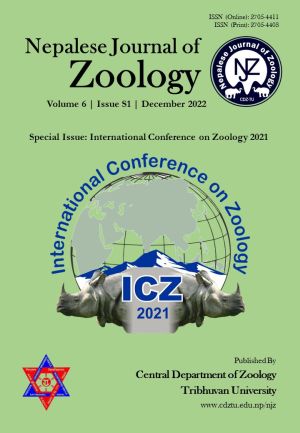Molecular phylogeny of swallowtail butterflies (Lepidoptera: Papilionidae) based on mitochondrial cytochrome c oxidase I (COI) gene from Bangladesh
DOI:
https://doi.org/10.3126/njz.v6iS1.50523Keywords:
Butterfly, DNA barcode, Evolutionary history, Graphium spp., Species identificationAbstract
Swallowtail butterflies (Papilionidae) are among the best-known insects in the world. Mitochondrial cytochrome c oxidase I (COI, 642 bp) gene from nine species under four genera of swallowtail butterflies was sequenced and submitted to the GenBank. Basic local alignment search tool (BLAST) analysis showed that the COI gene sequences of these nine butterflies matched those of respective species from different geographical areas (99-96% similarity). The interspecific genetic divergence among swallowtail species was between 0.01–0.15%. Phylogenetic tree constructed using the maximum likelihood algorithm showed that the species of swallowtail butterflies were originated from a common ancestor where Papilio polytes, Papilio nephelus, Papilio demoleus, Papilio memnon and Papilio polymnestor belonged to a cluster. On the other hand, Graphium agamemnon, Atrophaneura varuna and Pachliopta aristolochiae belonged to another cluster. In the TCS haplotype network, considerable genetic divergence was observed among the nine species of swallowtail butterflies. Both phylogenetic and haplotype analyses showed that Graphium doson was genetically most divergent among the swallowtail butterflies studied in the present study. These results indicate that Graphium spp. might be the good model system to uncover many biological processes like color vision and image processing in organisms.
Downloads
Downloads
Published
How to Cite
Issue
Section
License
Copyright (c) 2022 Md Monwar Hossain, Ananna Ghosh, Fahmina Sarkar Borsha, Md Khayrul Hasan , Muhammad Sohel Abedin, Abdul Jabber Howlader

This work is licensed under a Creative Commons Attribution-NonCommercial 4.0 International License.
This license enables reusers to distribute, remix, adapt, and build upon the material in any medium or format for noncommercial purposes only, and only so long as attribution is given to the creator.

